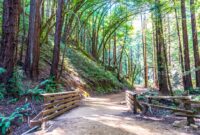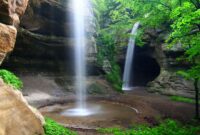Great hiking places near me offer a fantastic escape from the everyday. This guide explores nearby trails, catering to various fitness levels and preferences, from leisurely strolls to challenging climbs. We’ll delve into trail details, highlighting scenic views, amenities, and potential wildlife encounters, ensuring a safe and enjoyable outdoor adventure. Discover the perfect trail to match your experience and create unforgettable memories.
We’ll cover everything from finding trails suited to your preferred difficulty and scenery to understanding safety considerations and accessing helpful resources. Whether you’re a seasoned hiker or a beginner, this guide will help you find the ideal hiking spot near you.
Understanding User Location & Preferences
To provide you with the most relevant hiking recommendations, our system needs to understand your location and preferences. This involves gathering information about your geographical location and the type of hiking experience you’re seeking. We use this information to filter and present a curated selection of trails perfectly suited to your needs. This ensures you find the ideal hiking adventure near you.
Determining user location and preferences is a crucial first step in personalizing the hiking experience. Accurate location data allows us to identify nearby trails, while preference data ensures that the suggested trails match your desired difficulty, type, and scenery.
User Location Determination
Our system employs a combination of techniques to determine your location. Primarily, we utilize your IP address, which provides a general geographical area. For more precise location data, we may also request access to your device’s geolocation services. This allows for a more accurate determination of your current location and enables us to display nearby hiking trails with greater precision. The level of precision depends on the user’s privacy settings and the availability of geolocation data. For example, an IP address might pinpoint a city, while geolocation services could pinpoint a specific neighborhood or even a street address, depending on the user’s device capabilities and privacy settings.
Hiking Difficulty Preferences
Understanding your preferred hiking difficulty level is essential for suggesting suitable trails. We categorize trails as easy, moderate, or strenuous. Easy trails typically involve minimal elevation gain and relatively smooth terrain, suitable for casual hikers. Moderate trails offer a more challenging experience with some elevation changes and potentially rougher terrain. Strenuous trails are designed for experienced hikers, often involving significant elevation gain, steep inclines, and potentially challenging terrain. We will ask you to select your preferred difficulty level to filter the trail recommendations appropriately.
Hiking Type Preferences
Different hikers prefer different types of trails. We distinguish between loop trails, out-and-back trails, and point-to-point trails. Loop trails return you to your starting point, creating a circular route. Out-and-back trails involve hiking to a specific point and then returning along the same path. Point-to-point trails require separate transportation to return to the starting point, as they begin and end at different locations. Understanding your preference for these trail types ensures that we only present trails that align with your preferred hiking style.
Scenery Preferences
The natural beauty of the surrounding environment is a major draw for hikers. We allow you to specify your preferred scenery, such as mountains, forests, lakes, deserts, or coastal areas. This allows us to filter the trail recommendations to include those that offer the type of scenery you find most appealing. For instance, a user who prefers mountain views will be shown trails with panoramic vistas, while a user who prefers forest trails will be presented with trails that wind through wooded areas.
Creating Visual Representations
To truly appreciate the hiking trails near you, it’s helpful to visualize the experience before you set out. The following descriptions aim to paint a picture of the atmosphere and sensory details you can expect, along with practical gear recommendations and a sample trail map.
Atmospheric Descriptions of Hiking Locations
Location 1: Redwood National Park (Example): Imagine stepping into a cathedral of towering redwoods, sunlight dappling through the dense canopy in shafts of golden light. The air is cool and damp, carrying the earthy scent of decaying redwood needles and the subtle sweetness of pine. The only sounds are the gentle rustling of leaves in the breeze and the occasional call of a bird hidden high in the branches. A sense of peace and tranquility washes over you as you walk amongst these giants.
Location 2: Coastal Trail (Example): The salty tang of sea air fills your lungs as you walk along the rugged coastline. Waves crash against the rocks below, their rhythmic roar a constant soundtrack to your hike. The wind whips through your hair, carrying the cries of seagulls overhead. You’ll see dramatic cliffs, sandy coves, and perhaps even glimpses of marine wildlife. The vibrant colors of wildflowers and the stark beauty of the rock formations create a breathtaking panorama.
Location 3: Mountain Trail (Example): The air thins as you ascend, the scent of pine and wildflowers growing stronger with each step. You might hear the distant call of a hawk circling overhead, or the rustling of small animals in the underbrush. The views are panoramic, stretching out to distant valleys and peaks. The sun warms your face as you take in the breathtaking vista, a feeling of accomplishment mixed with the awe-inspiring beauty of nature.
Recommended Hiking Gear by Difficulty Level
Choosing the right gear significantly impacts your hiking experience. The list below provides recommendations based on trail difficulty.
- Easy Trails: Comfortable walking shoes, water bottle, light snacks, sunscreen, hat.
- Moderate Trails: Sturdy hiking boots, backpack (10-20 liters), water (at least 2 liters), energy bars or trail mix, rain jacket, first-aid kit, map and compass/GPS.
- Difficult Trails: High-quality hiking boots, larger backpack (30+ liters), ample water and high-energy food, trekking poles, layers of clothing for changing weather conditions, headlamp or flashlight, emergency blanket, whistle, navigation tools (map, compass, GPS), fully charged mobile phone.
Sample Hiking Trail Map: Redwood National Park (Example)
This map depicts a simplified version of a trail within Redwood National and State Parks. It illustrates the general layout and key points of interest. Remember to always carry a detailed map and compass/GPS for accurate navigation.
Imagine a map showing a loop trail. The trail starts at a designated parking area (labeled “Trailhead”). The path initially follows a relatively flat, well-maintained trail through a grove of smaller redwood trees (labeled “Grove Trail”). After approximately 1 mile, the trail begins to ascend gradually (labeled “Gentle Ascent”). This section continues for about 0.75 miles, leading to a scenic overlook (labeled “Overlook Point”) offering panoramic views of the surrounding forest. From the overlook, the trail descends slightly (labeled “Gentle Descent”) for approximately 0.5 miles, passing by a small creek (labeled “Creek Crossing”). The trail then continues on a relatively flat path for about 1 mile before looping back to the trailhead. The entire loop is approximately 3.25 miles.
Ultimate Conclusion
Exploring the great hiking places near you offers a wealth of opportunities for recreation and rejuvenation. By carefully considering your preferences and utilizing the resources provided, you can confidently plan safe and rewarding hiking experiences. Remember to always prioritize safety, respect the environment, and enjoy the beauty of the natural world around you. Happy trails!




